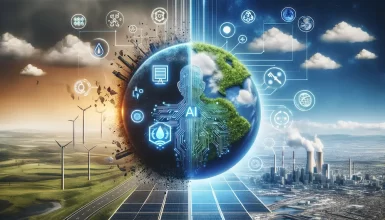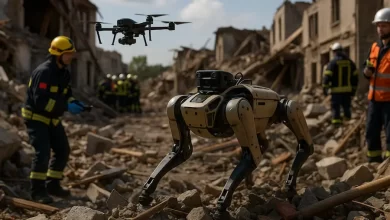Climate Tech: How AI Is Fighting Climate Change


This blog post explores the crucial role of artificial intelligence and climate change solutions in addressing the global climate crisis. It discusses how AI is shaping innovative approaches to combat climate change, including advanced carbon tracking methods and technologies that improve emissions monitoring. The article highlights the significance of Green AI, which focuses on reducing the carbon footprint of AI systems themselves while offering scalable solutions to environmental challenges. Furthermore, it outlines actionable steps that individuals and organizations can take to leverage AI for a more sustainable future, emphasizing the potential of technology to create positive change. Overall, the post underscores the synergy between artificial intelligence and climate change initiatives, showcasing how smart technology can drive meaningful progress in achieving sustainability goals.
How Artificial Intelligence Is Shaping Climate Change Solutions



Artificial Intelligence (AI) is becoming a crucial tool in developing effective solutions for climate change. With the ability to analyze vast datasets rapidly and provide actionable insights, AI climate solutions are helping organizations and governments make informed decisions. These advanced technologies facilitate monitoring environmental changes, optimizing resource usage, and enhancing predictive capabilities, ultimately supporting the fight against climate change.
Key Aspects of AI Climate Solutions:
- Data Analysis: AI algorithms analyze patterns in climate data to predict future trends.
- Resource Optimization: AI models optimize energy consumption, reducing carbon footprints.
- Real-time Monitoring: Sensors and AI systems monitor environmental conditions in real time.
- Carbon Tracking: AI tools efficiently track greenhouse gas emissions for better management.
- Climate Modeling: AI enhances the accuracy of climate models, aiding scientific research.
- Predictive Maintenance: AI predicts equipment failures, leading to reduced downtime and resource wastage.
- Behavioral Insights: AI analyzes user behavior to promote sustainable practices effectively.
The integration of AI into climate change tech is not only expanding capabilities but also ensuring that solutions are scalable. By leveraging machine learning and natural language processing, businesses can analyze customer feedback and adapt their strategies towards more sustainable products. This adaptability strengthens the approach to climate change, meeting both organizational and environmental goals.
Moreover, the role of AI extends to enhancing collaboration among stakeholders. Through platforms powered by AI, data sharing becomes seamless, allowing researchers, businesses, and policymakers to work together more efficiently. Coordinated efforts backed by AI analytics can lead to significant innovations in climate change solutions, fostering a collective response to environmental challenges.
Understanding AI Carbon Tracking Methods and Technologies
Artificial Intelligence plays a pivotal role in enhancing carbon tracking methods, offering innovative solutions for environmental monitoring. By utilizing AI, organizations can not only improve the accuracy of their emissions inventories but also streamline reporting processes. This advancement is critical as businesses and governments strive to meet their climate goals through effective data utilization. AI-driven insights enable a more profound understanding of emissions sources, ultimately fostering sustainable practices across various sectors.
AI carbon tracking technologies utilize a variety of tools and methodologies to gather and analyze data. These include satellite imagery, sensor networks, and machine learning algorithms, which work together to create comprehensive carbon footprints. The ability to process vast amounts of data in real-time enhances the reliability of carbon measurements and helps identify specific areas for improvement. Furthermore, these technologies enable organizations to monitor their environmental impact continuously, thus promoting accountability and transparency.
| Technology | Description | Benefits |
|---|---|---|
| Satellite Monitoring | Utilizes satellite data to assess carbon emissions from different geographic areas. | Global coverage and real-time data acquisition. |
| IoT Sensors | Employs internet-connected devices to monitor air quality and emissions levels. | High accuracy and localized data collection. |
| Machine Learning | Analyzes historical data to predict future emissions trends. | Informed decision-making and proactive management. |
However, the implementation of AI carbon tracking is not without its challenges. For instance, the integration of diverse data sources can be complex and may require specialized knowledge and resources. Additionally, ensuring data privacy and compliance with regulations adds another layer of difficulty. Moreover, the varying availability of technological infrastructure across regions can hinder the adoption of these advanced methods, particularly in developing areas.
Key Technologies in Carbon Tracking
Several key technologies are driving advancements in AI carbon tracking. These technologies are essential not just for accurately measuring carbon emissions but also for facilitating strategic interventions aimed at reducing those emissions. By leveraging the power of GPS, automated reporting systems, and advanced analytics, organizations can fine-tune their operations for better sustainability outcomes.
Steps to Implement Effective AI Carbon Tracking:
- Assess current carbon emissions data and establish baselines.
- Identify key AI technologies suitable for your operations.
- Engage stakeholders to ensure data accuracy and integrity.
- Integrate AI tools with existing data collection systems.
- Train staff on new technologies and data management practices.
- Monitor AI-driven results and adjust strategies as necessary.
- Report findings to demonstrate accountability and progress.
In conclusion, embracing AI carbon tracking technologies presents substantial opportunities for organizations aiming to mitigate their environmental impact. By understanding the key technologies involved and the challenges faced, stakeholders can make informed decisions that contribute to a more sustainable and responsible future, effectively utilizing artificial intelligence to combat climate change.
The Role of Green AI in Combating Climate Issues
Green AI represents a pivotal shift in how artificial intelligence is being utilized to address climate challenges. By focusing on sustainable methods that reduce the energy consumption of AI systems, the integration of artificial intelligence and climate change initiatives is gaining momentum. This approach not only enhances the performance of AI models but also aligns with global efforts to curtail greenhouse gas emissions. The proactive adoption of green AI is necessary for innovating in sectors like energy, transportation, and agriculture, where technology plays a vital role in environmental stewardship.
Benefits of Green AI Technologies:
- Reduced energy consumption in computing
- Lower carbon footprints associated with AI model training
- Improved efficiency of renewable energy systems
- Optimized resource management in agriculture
- Enhanced predictive capabilities for climate modeling
- Increased public awareness of climate issues through AI-driven initiatives
- Support for sustainable urban development strategies
Furthermore, the application of green AI technologies allows for the real-time analysis of environmental data, enabling quicker responses to ecological changes. These advanced systems can sift through massive datasets, identifying patterns that can not only inform policymakers but also propel preventative strategies. Experts agree that leveraging artificial intelligence and climate change can enhance decision-making processes, driving us toward sustainable solutions that mitigate environmental impact.
Examples of Green AI Initiatives
Several organizations are leading the way in developing innovative green AI solutions. One notable example is the use of AI algorithms to optimize renewable energy production, which aids in predicting energy output from solar and wind sources more accurately. This not only minimizes waste but also maximizes efficiency in energy distribution systems. Moreover, companies are harnessing the power of AI to enhance energy-efficient building designs, ensuring that both new constructions and retrofitted buildings consume less energy without sacrificing comfort.
Actionable Steps to Leverage AI for a Sustainable Future
Embracing Artificial Intelligence and Climate Change innovations can amplify our efforts towards a sustainable future. AI climate solutions can optimize various processes, from energy consumption in buildings to supply chain management in agriculture. By harnessing data analytics, machine learning, and predictive modeling, organizations can improve their decision-making capabilities, ultimately reducing their carbon footprint. The application of climate change tech can enable more efficient resource management and enhance resilience to climate impacts.
Next Steps to Implementing Climate Change Tech:
- Identify the key areas where AI can enhance existing sustainability practices.
- Invest in training programs for staff to effectively use AI tools.
- Collaborate with tech providers to integrate AI systems tailored to your needs.
- Utilize machine learning algorithms to analyze energy consumption data.
- Monitor and evaluate outcomes to ensure the effectiveness of AI climate solutions.
- Engage with stakeholders and share insights to foster community involvement.
- Continuously refine and adapt AI applications based on feedback and new discoveries.
By following these actionable steps, organizations can systematically adopt climate change tech to mitigate climate-related challenges effectively. Moreover, the integration of AI technologies empowers stakeholders to visualize data trends and make informed predictions. As investment in AI climate solutions grows, so will our collective ability to combat the effects of climate change, ensuring a more sustainable planet for future generations.
Artificial intelligence / humanaifuture.com




